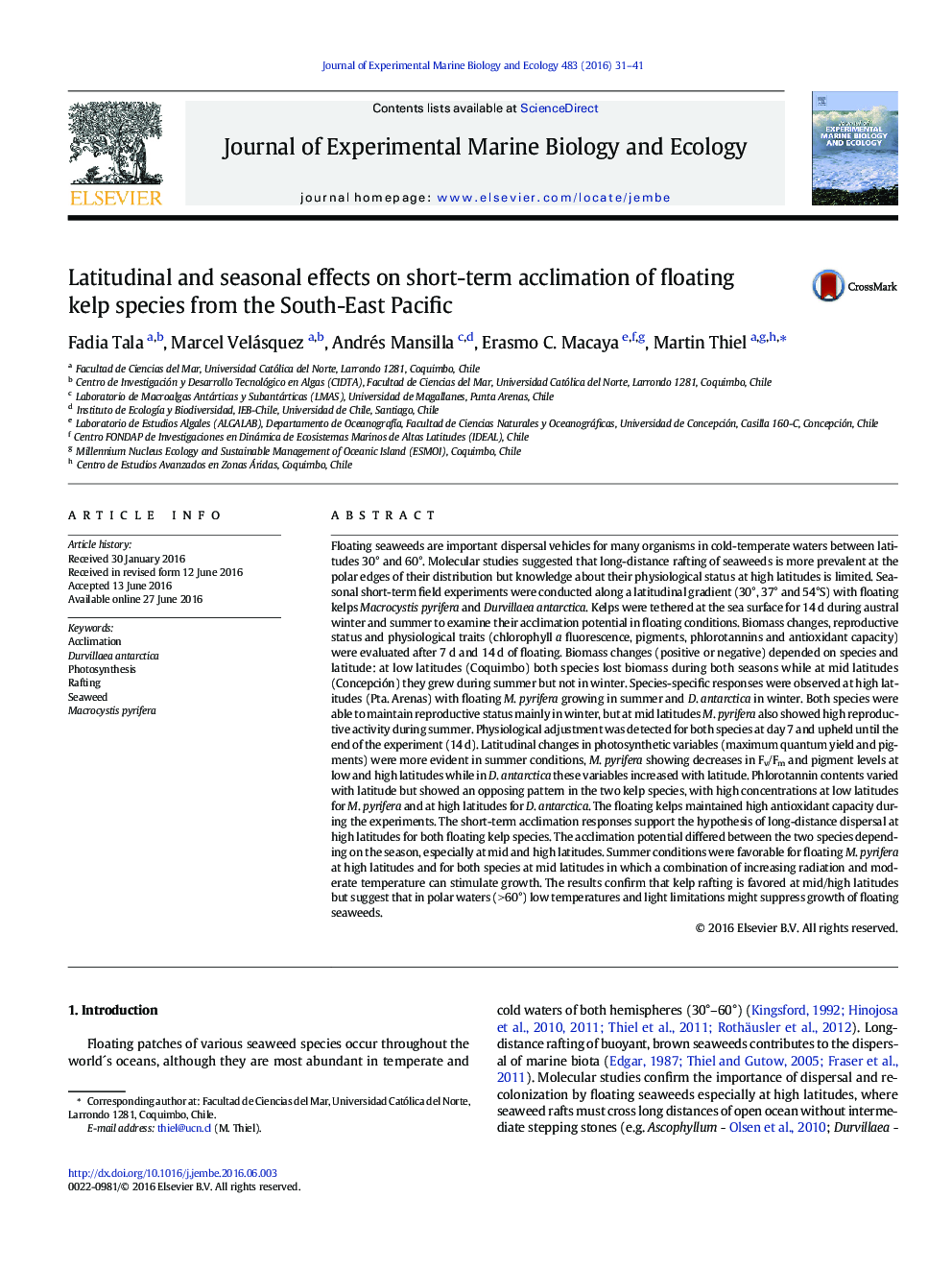| کد مقاله | کد نشریه | سال انتشار | مقاله انگلیسی | نسخه تمام متن |
|---|---|---|---|---|
| 4395214 | 1618392 | 2016 | 11 صفحه PDF | دانلود رایگان |
• Rafting of seaweeds is prevalent at polar edges of their distribution but knowledge about physiological status is limited.
• Floating Macrocystis pyrifera and Durvillaea antarctica survived 2 weeks experimentally tethered at 30°S, 37°S and 54°S.
• Floating kelps lost biomass at low latitude in both seasons, but gained at mid and high latitudes, at least in one season.
• Physiological acclimations occurred in both floating kelps, but differ between the two species depending on the season.
• Kelp rafting is favored at mid/high latitudes but light limitation in polar waters might suppress their growth in winter.
Floating seaweeds are important dispersal vehicles for many organisms in cold-temperate waters between latitudes 30° and 60°. Molecular studies suggested that long-distance rafting of seaweeds is more prevalent at the polar edges of their distribution but knowledge about their physiological status at high latitudes is limited. Seasonal short-term field experiments were conducted along a latitudinal gradient (30°, 37° and 54°S) with floating kelps Macrocystis pyrifera and Durvillaea antarctica. Kelps were tethered at the sea surface for 14 d during austral winter and summer to examine their acclimation potential in floating conditions. Biomass changes, reproductive status and physiological traits (chlorophyll a fluorescence, pigments, phlorotannins and antioxidant capacity) were evaluated after 7 d and 14 d of floating. Biomass changes (positive or negative) depended on species and latitude: at low latitudes (Coquimbo) both species lost biomass during both seasons while at mid latitudes (Concepción) they grew during summer but not in winter. Species-specific responses were observed at high latitudes (Pta. Arenas) with floating M. pyrifera growing in summer and D. antarctica in winter. Both species were able to maintain reproductive status mainly in winter, but at mid latitudes M. pyrifera also showed high reproductive activity during summer. Physiological adjustment was detected for both species at day 7 and upheld until the end of the experiment (14 d). Latitudinal changes in photosynthetic variables (maximum quantum yield and pigments) were more evident in summer conditions, M. pyrifera showing decreases in Fv/Fm and pigment levels at low and high latitudes while in D. antarctica these variables increased with latitude. Phlorotannin contents varied with latitude but showed an opposing pattern in the two kelp species, with high concentrations at low latitudes for M. pyrifera and at high latitudes for D. antarctica. The floating kelps maintained high antioxidant capacity during the experiments. The short-term acclimation responses support the hypothesis of long-distance dispersal at high latitudes for both floating kelp species. The acclimation potential differed between the two species depending on the season, especially at mid and high latitudes. Summer conditions were favorable for floating M. pyrifera at high latitudes and for both species at mid latitudes in which a combination of increasing radiation and moderate temperature can stimulate growth. The results confirm that kelp rafting is favored at mid/high latitudes but suggest that in polar waters (> 60°) low temperatures and light limitations might suppress growth of floating seaweeds.
Journal: Journal of Experimental Marine Biology and Ecology - Volume 483, October 2016, Pages 31–41
